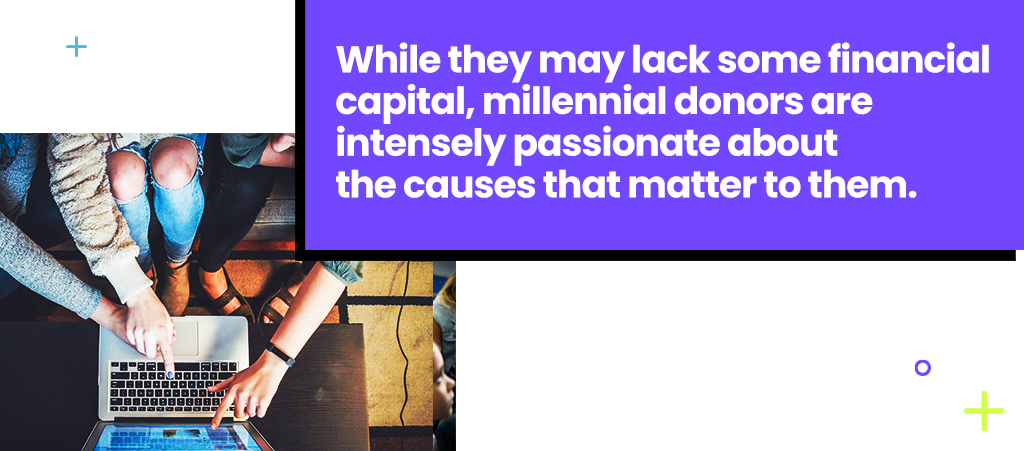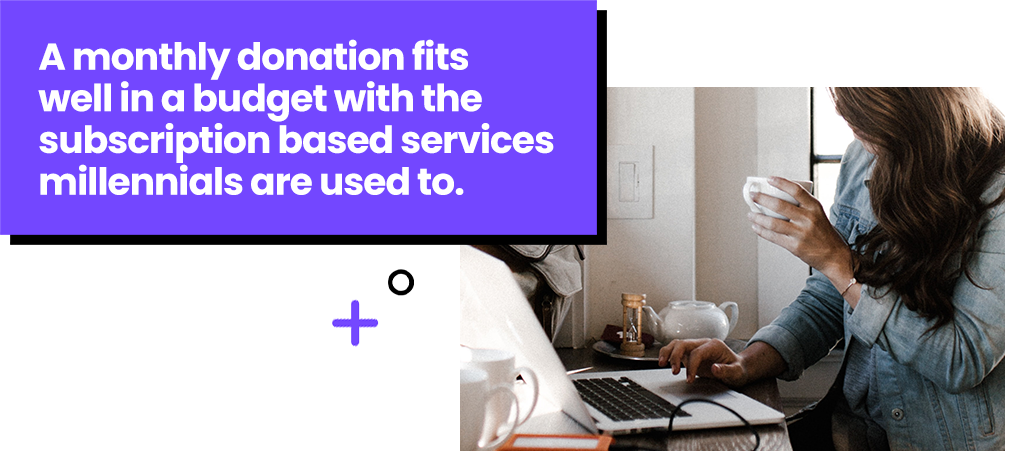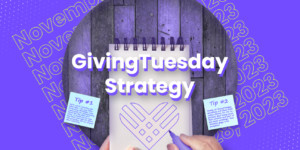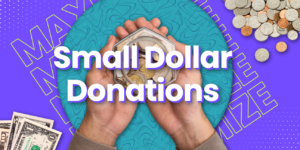The days when we would talk about millennials being the future are over. Older millennials are entering their 40s. The future is now, and you should have a specific plan to retain millennial donors after the appeal season.
Did you know, according to Nonprofit Source, millennials account for 11 percent of all charitable giving in the United States? In fact, 84 percent already give to charity in some way. All these donors might not have the means to make that large, organization changing gift just yet. However, they are intensely passionate about the causes close to them.
Having a plan for this demographic will help you develop a loyal donor base that will grow with your organization. But these donors are not like the generations that came before them.
So, you’ll need to try something different!
The tried-and-true methods you’ve used to raise funds and engage with older generations may not be as effective for retaining millennial donors.
What we know about millennials.
Most circles view millennials as those born between the early 1980s and mid-1990s. But before we share the best ways to get millennials to engage with your organization, it’s important to understand their unique relationship with charitable giving.
Millennials are at a crossroads. While those on the older side of this group are moving up in their careers and really starting to pull in income, younger millennials are still getting settled in their adult lives. So, many of these supporters won’t have the means to join your major donors yet.
But what they may lack in financial capital is made up for in their enthusiasm to improve the world.
Here’s what we know about millennial donors:
- Millennials are the activist generation. They may not be as financially stable as older generations. But they are avid supporters of the causes that matter most to them.
- They like to “test” organizations to see which aligns best with their goals and is deserving of continued support.
- Millennials are accustomed to managing monthly payments. Whether it’s Netflix, rent, or the latest iPhone, many millennials prefer monthly payments to an up-front expensive purchase.

Don’t fail the test!
You’ll have a problem retaining millennial donors if your organization doesn’t have a plan to steward each gift and engage supporters. Saying thank you and making donors feel special after every donation is important for every demographic.
But it’s even more critical for retaining millennial donors. As we’ve shared, what millennials may lack in financial capital, they make up for in enthusiasm.
And they want to make sure every dollar advances their goals as much as possible.
So, they often make several small “test” gifts before fully supporting an organization to see which will help them make the biggest impact.

The power of $5.
Put yourself in a millennial’s shoes. You’ve determined that you can donate just $50 to a cause that matters to you this year.
How would you decide what organization will really put your money to work? Which will help you make the biggest impact?
Millennials will take $20 of that $50 and make four $5 donations to four different organizations with similar goals. They are testing to see which organization is most deserving of the remaining $30 and possibly a lifetime of support!
Let’s say two organizations shrug off the stewardship process. “It’s only $5. The donation is hardly worth the paper and postage costs of sending a thank you letter,” they might think. Big mistake!
Nonprofits that fail to respond and thank a donor for their gift fail the test. They will likely never see another dollar from that donor.
The remaining two organizations reach back out with a thank you message. The first sends a generic email in response thanking the donor for their nonspecific gift and includes a link to their donation page. But the millennial just heard, “Hey, you sent us some money. Thanks, got any more?”
The last nonprofit takes the time to send a handwritten letter or personalized email from a board member. They thank the donor for their generosity, explain the impact the gift will have on their shared goals, and invite them to continue their support with an invitation to the organization’s next volunteer outing.
Which organization are you going to give that last $30 to? Which do you think will make each fundraising dollar go further? Which of them do you expect to keep you in the loop about their future activities?
Most importantly, which one will you donate $50,000 to when you are the CEO of a major tech company 20 years from now?
READ MORE: Can your nonprofit send better thank you’s?

Millennials love monthly giving.
Now, let’s think short term. None of the above is meant to imply you can’t make the most of these donors now!
However, you need to know how they are comfortable giving. There are many ways to meet millennial donors where they are at by using social media, text-to-give campaigns, or by promoting monthly giving.
Millennials are subscription-based consumers. The long-term cost is not as important to them as meeting their needs on a monthly budget. Sure, they could save in the long run if they bought a new smartphone upfront. But that could mean missing a rent payment or eating nothing but ramen noodles until their next payday.
The thought of financing or leasing a smartphone might seem silly to older generations. But it makes a lot of sense for millennials. Spending $1,000 upfront for the newest iPhone might not be an option. But they can fit a $50 monthly payment into their budget. And they also get the added benefit of upgrading to the newest version at their convenience.
A $200 gift at the end of the year might not be an option. However, they can probably find room in their monthly budget for a $20 recurring gift. And in this scenario, you’d raise an additional $40 per year from this donor.
And don’t forget to let them know about other benefits you offer to monthly donors!
READ MORE: Building monthly giving into your fundraising strategy.
Preparing for the Future
Millennials make up roughly 26 percent of the US population. 40 percent of them are already enrolled in a monthly giving program. 46 percent donate to crowdfunding campaigns. 55 percent attend fundraising events, and 64 percent volunteer in their local communities.
So, does your nonprofit have the tools and plan in place to start retaining millennial donors?









